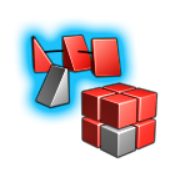Replicate
Replicate a source object along a path by defining the number of copies or by defining the distance between each copy.
- On the ribbon, click the Modify tab.
-
In the Replicate group, click the
Replicate icon.

In the guide bar, Object is automatically highlighted. -
Click the source object you'd like to replicate. The source object can be a
NURBS curve, NURBS surface, or PolyNURBS surface.
In the guide bar, Path is automatically highlighted
-
Click the replication path. The replication path can be either a NURBS curve or
NURBS surface.
By default, three copies are created and evenly spaced along the path.
-
Select a replication method:
- Copy: Select this option if you want to define the number of copies. The distance between each copy is calculated automatically.
- Step: Select this option if you want to define the distance between each copy. The number of copies is calculated automatically.
-
Do one of the following:
And if the path is a curve And if the path is a surface If you selected Copy Type the number of Copies along U. Type the number of Copies along U and Copies along V. The number of copies in each direction is equal to the number of copies along each face, not the total surface. Note: For surfaces with multiple faces, these are the number of copies per face.If you selected Step Type the Step U. You can enter a value between 0 and 1. Type the Step U and Step V. -
Restrict the replication to only a portion of the path:
To Do this Define the start point in the U direction - Drag the U start point.
- Click the U start point, and then enter the Start U.
Define the end point in the U direction - Drag the U end point.
- Click the U end point, and then enter the End U.
Define the start point in the V direction - Drag the V start point.
- Click the V start point, and then enter the Start V.
Define the end point in the V direction - Drag the V end point.
- Click the V end point, and then enter the End V.
Define the 3D distance along the curve - Drag the U start point and U end point.
- Type the Start curve and End curve.
- To combine the output, select Combined output.
- Right-click and mouse through the check mark to exit, or double-right-click.
Transform the Replicated Objects
- Double-click the replicated object to enter edit mode.
- In the Control Panel, click the Advanced tab.
-
Define how rotation and scaling are applied to the replicated object:
- Select a Transformation Type:
Option Description Last Copy Rotation and scaling are applied to the last copy, with each previous copy decreasing linearly. Incremental Rotation and scaling are applied to the first copy, with each successive copy increasing linearly. Constant Rotation and scaling are applied to all copies. - Define the rotation and scaling factors:
Option Description Note Rotation Type a rotation angle for the x, y, and z axes. Scaling Type a scaling factor for the x, y, and z axes. To readjust copies so that their position follows the distance between consecutive copies rather than the theoretical distance between the centers of objects, it is recommended to select Autocompensation of distance in scaling.
The default of (1,1,1) produces no scaling effect.
- Select a Transformation Type:
-
Add a noise factor:
Option Description Note Translation Noise To apply a random effect on translation, enter a translation distance for the x, y, and z axes. The default of (0,0,0) produces no translation noise. Rotation Noise To apply a random effect on rotation, enter a rotation angle for the x, y, and z axes. The default of (0,0,0) produces no rotation noise. Scaling Noise To apply a random effect on scaling, enter a scaling factor for the x, y, and z axes. The default of (0,0,0) produces no scaling noise. Noise Alter the sequence of random numbers that determine the noise factor applied to transformations. - To open the Move tool, click one of the four blue dashes on the source object.
- Right-click and mouse through the check mark to exit, or double-right-click.